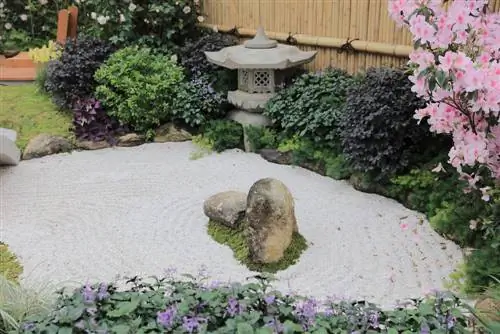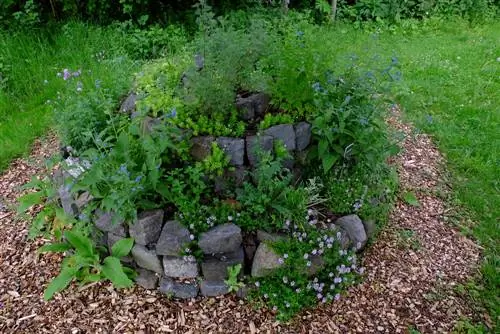- Author admin [email protected].
- Public 2023-12-16 16:46.
- Last modified 2025-06-01 06:02.
If your perennial garden thrives beautifully as the seasons change, you've done everything right. Getting there depends on the right preparatory work, smart plant selection and skillful planting technique. Find out how to do it here.

How do I create a perennial garden?
To create a perennial garden, first choose a suitable theme and create a sketch plan. Take into account site conditions, leading perennials, companion perennials, filler plants and bulb flowers. Ideally, plant perennials in the fall and prepare the soil thoroughly to prevent weed growth.
Choose a topic and create a plan - This is how it works
The local conditions determine which perennials thrive he althily and vitally in your garden. However, the design theme for your perennial garden is not firmly cemented. Rather, you can draw from a multifaceted pool of creative leitmotifs for all lighting and floor conditions. The following selection presents you with popular examples:
- Sunny to semi-shady location, fresh, moist soil: natural perennial garden, varied cottage garden
- Sunny location with acidic garden soil: heather garden in dry soil, bog garden in permanently moist soil
- Full sun location with gravelly dry soil: prairie garden, rock garden, Japanese garden
- Shady, moist location: shade garden with foliage perennials and shade-tolerant flowering perennials
Create a precise plan sketch with information about the specific site qualities in order to coordinate the plant selection. Integrate other design elements into the planning, such as small water worlds, seats or a gazebo.
It's the mixture that counts - tips for a creative variety melange
There is a huge pool of suitable perennials for every garden theme and every area of life. To prevent your perennial garden from turning into a disorganized hodgepodge of plants, we recommend the following structuring:
- Lead perennials choose as scaffolding, such as majestic delphiniums or elegant Chinese reeds
- Choose companion perennials that harmonize with the leading perennials, such as coneflowers or pennisetum
- Filling plants as gap fillers and floral bridging of different flowering times, such as purple bells
- Onion flowers as colorful start signals in spring, like snowdrops or Marchenbrecher
A flowering calendar ensures that the perennials seamlessly pass the floral scepter to each other. As a rule of thumb, a plant density of 6 to 8 perennials per square meter has proven to be effective in practice. A distribution of 10 to 15 percent of leading perennials, 30 to 40 percent of accompanying perennials and 50 to 60 percent of filler perennials is recommended.
Planting perennials skillfully - tips on planting time and planting technique
The best time to plant perennials is autumn. Young plants root quickly in soil warmed by the sun, so that they can start off with a vital growth lead next spring. Rake the soil thoroughly, carefully removing stones, roots and weeds. Meanwhile, place the still potted root balls in water. With the sketch plan in hand, first lay out the perennials in the garden to assess their appearance.
If the arrangement of the plants meets your expectations, dig planting pits with twice the volume of the root ball. Plant the potted perennials in it, press the soil firmly with your hands and water.
Tip
Prepare the garden soil for your perennial garden and effectively prevent annoying weeds now. Anyone who lays a weed fleece (€19.00 at Amazon) in this phase of preparation will rarely have to deal with dandelions, groundweed and the like later on.






